英语词汇学课后答案张维友编
- 格式:doc
- 大小:111.50 KB
- 文档页数:28
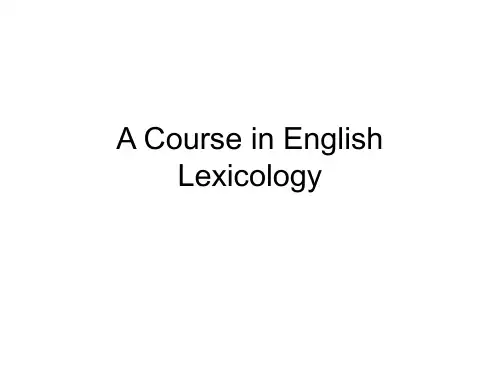
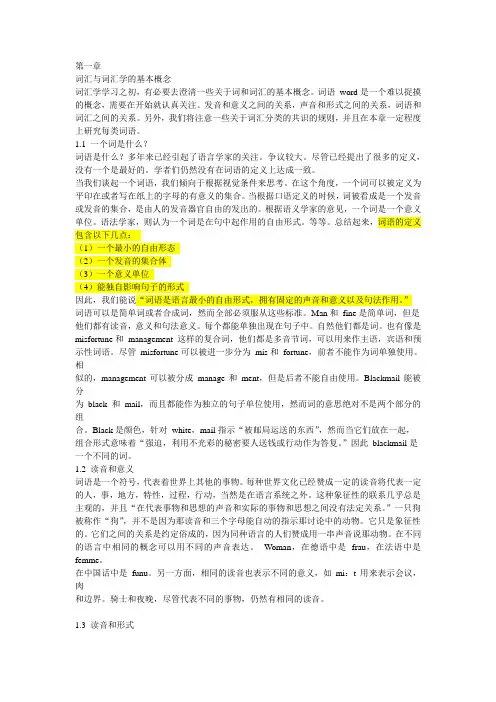
第一章词汇与词汇学的基本概念词汇学学习之初,有必要去澄清一些关于词和词汇的基本概念。
词语word是一个难以捉摸的概念,需要在开始就认真关注。
发音和意义之间的关系,声音和形式之间的关系,词语和词汇之间的关系。
另外,我们将注意一些关于词汇分类的共识的规则,并且在本章一定程度上研究每类词语。
1.1 一个词是什么?词语是什么?多年来已经引起了语言学家的关注。
争议较大。
尽管已经提出了很多的定义,没有一个是最好的。
学者们仍然没有在词语的定义上达成一致。
当我们谈起一个词语,我们倾向于根据视觉条件来思考。
在这个角度,一个词可以被定义为平印在或者写在纸上的字母的有意义的集合。
当根据口语定义的时候,词被看成是一个发音或发音的集合,是由人的发音器官自由的发出的。
根据语义学家的意见,一个词是一个意义单位。
语法学家,则认为一个词是在句中起作用的自由形式。
等等。
总结起来,词语的定义包含以下几点:(1)一个最小的自由形态(2)一个发音的集合体(3)一个意义单位(4)能独自影响句子的形式因此,我们能说“词语是语言最小的自由形式,拥有固定的声音和意义以及句法作用。
”词语可以是简单词或者合成词,然而全部必须服从这些标准。
Man和fine是简单词,但是他们都有读音,意义和句法意义。
每个都能单独出现在句子中。
自然他们都是词。
也有像是misfortune和management 这样的复合词,他们都是多音节词,可以用来作主语,宾语和预示性词语。
尽管misfortune可以被进一步分为mis和fortune,前者不能作为词单独使用。
相似的,management可以被分成manage和ment,但是后者不能自由使用。
Blackmail能被分为black和mail,而且都能作为独立的句子单位使用,然而词的意思绝对不是两个部分的组合。
Black是颜色,针对white,mail指示“被邮局运送的东西”,然而当它们放在一起,组合形式意味着“强迫,利用不光彩的秘密要人送钱或行动作为答复。
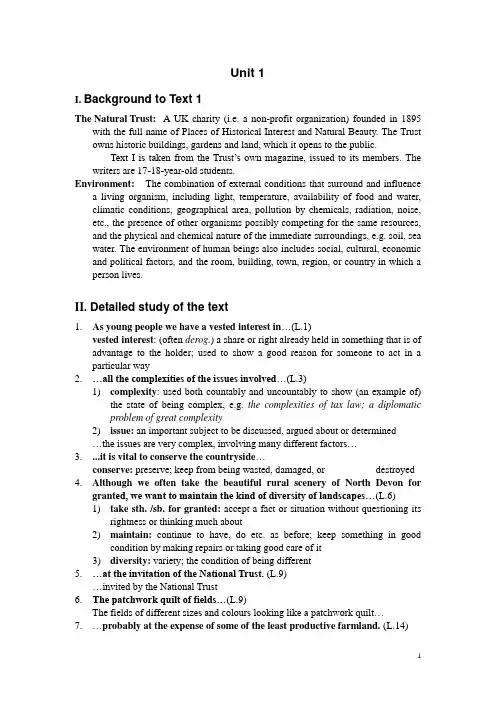
Unit 1I. Background to Text 1The Natural Trust: A UK charity (i.e. a non-profit organization) founded in 1895 with the full name of Places of Historical Interest and Natural Beauty. The Trust owns historic buildings, gardens and land, which it opens to the public.Text I is taken from the Trust’s own magazine, issued to its members. The writers are 17-18-year-old students.Environment:The combination of external conditions that surround and influencea living organism, including light, temperature, availability of food and water,climatic conditions, geographical area, pollution by chemicals, radiation, noise, etc., the presence of other organisms possibly competing for the same resources, and the physical and chemical nature of the immediate surroundings, e.g. soil, sea water. The environment of human beings also includes social, cultural, economic and political factors, and the room, building, town, region, or country in which a person lives.II. Detailed study of the text1. As young people we have a vested interest in…(L.1)vested interest: (often derog.) a share or right already held in something that is of advantage to the holder; used to show a good reason for someone to act in a particular way2. …all the complexities of the issues involved…(L.3)1) complexity: used both countably and uncountably to show (an example of)the state of being complex, e.g. the complexities of tax law; a diplomaticproblem of great complexity2) issue: an important subject to be discussed, argued about or determined…the issues are very complex, involving many different factors…3. ...it is vital to conserve the countryside…conserve: preserve; keep from being wasted, damaged, or destroyed 4. Although we often take the beautiful rural scenery of North Devon forgrant ed, we want to maintain the kind of diversity of landscapes…(L.6)1) take sth. /sb. for granted: accept a fact or situation without questioning itsrightness or thinking much about2) maintain:continue to have, do etc. as before; keep something in goodcondition by making repairs or taking good care of it3) diversity: variety; the condition of being different5. …at the invitation of the National Trust. (L.9)…invited by the National Trust6. The patchwork quilt of fields…(L.9)The fields of different s izes and colours looking like a patchwork quilt…7. …probably at the expense of some of the least productive farmland. (L.14)…by sacrificing some of the poorest or barren farmlandat the expense of: with the loss of; by harming or reducing8. If this means paying farmers to do things other than produce food, then so beit. (L.14)If this means that we pay the farmers so that they will use their farmland to do other things instead of growing food crops, let it be that way.so be it: let it be that way; all right9. …they look out of place beside their broadleaf neighbours. (L.19)…on appearance they do not match the broadleaf woods beside them.our of place: not in the proper or usual place; (fig.) inappropriate10. …most of us would like to see more people have a right of access toappreciate what is there. (L.22)…most of us would like to see more people have the right and be able to go and enjoy the natural scenery there.have access to: be able to reach or use11. But we do not want a gigantic rural theme park…But we do not want huge/tremendous country park which specializes in certain activities…12. However, in selected and well-segregated areas more active involvement inthe countryside should be encouraged…(L.26)However, it is good/desirable to have active activities in certain selected and isolated areas…13. …we, after all, an interactive, hands-on generation. (L.27)…we are after all a generation which is trained to be active in doing thins about or interact with our environment.hands-on: involving or offering active participation rather than theory; direct, practical14 More footpaths and bridleways with interpretive information would alsohelp. (L.30)It would be helpful to build more footpaths and paths for riders with relevant information about them.bridleway: paths for riders and walkers only but not for vehicles15. …but makes the countryside experience too cosmetic… (L.34)…make the countryside experience too artificial(implying not seeing things in their natural state…cosmetic:intended to improve only appearances; superficially improving or beneficial16. Perhaps we are a little cynical…(L.38)cynical: critical17. …aims of bodies like the National Trust sometimes had built-in conflictbetween… (L.39)…the purposes of the organizati ons sometimes were contradictory in themselves…built-in conflict: intrinsic disagreement; innate conflict18. …in a state that is not damaged beyond repair. (L.46)…in a state that is not damaged in such a way that there is no way to restore it.beyond repair: not being able to be repaired19. …while some saw a few turbines, even in “our back yard” in North Devon,as a small price to pay for clean electricity. (L.52)…some think that building a few water turbines inland is not costly, but we can get electricity without polluting the air or damaging environment.20. The amount of agrochemicals used in the countryside disturbs us. (L.55)We are upset and worried about the quantity of chemicals used for crops in the countryside.21. The suggestion of nitrogen quotas seems a good way of reducing onepotential source of pollution… (L.56)It seems a good way to set limited quotas for nitrogen content so as to reduce the possible source of pollution…1) quota: quotas (pl) the number or quantity officially determined or fixed2) potential: (adj.) capacity of coming into being or action, latent; (n.) thecapacity for use or development, possibility22. …but the likelihood of the government agreeing to it seems slim in view ofthe power of the manufacturers. (L.58)…but it seems that the government is not very likely to agree to do so as the agrochemical producers are very powerful.1) slim: (of hope, probability, etc.) very small; slight2) in view of: having regard to; considering23. …but making dipping voluntary is not an adequate solution… (L.61)…it is not enough just to make dipping sheep in chemicals compulsory…; even when a policy is made saying that dipping sheep in chemicals is not required, this may not solve the problem completely…dipping: washing sheep by immersing them in a vermin-killing liquid24. This is a debate that will not go away in the future! (L.65)The argument (there are better methods than controlling predators by hunting) will continue in the future.25. …we got the sense that all the various organizations involved are not pullingin the same direction… (L.68)…we felt that the organizations or groups which are involved differ in their action or are acting against each other…get the sense: have a feeling; feel27. …generate more in come from and for the countryside… (L.72)…make use of the countryside to create or produce more moneyand use the money for it…generate: produce; bring into existenceIII. Answers for Text 1Skills DevelopmentPre-reading1. 3)2. and3. have no hard and fast answer. It depends on students’ personal experience orknowledge of the countryside.Reading1. Anything suitable is acceptable, such as “Suggestions for Conservation of theCountryside”.2. 3)3. 1) Money should be invested.Diversity of landscape should be maintained.There should be more broadleaf woodland and moorland.Coniferous woodland should be reduced.2) Completely natural countryside.Activity areas3) No4) Not adequate actionSafer alternatives must be found.5) Sometimes the Trust faces a conflict between its objectives and its need tomake money.The activities of the Trust are not properly coordinated with the activities ofother similar organizations4. 1) F 2) T3) T 4) T5) F 6) T7) F 8) T9) T 10) F11) T 12) F5. ●main diversity of landscape●increase broadleaf woodland and moorland●reduce coniferous woodland●provide activities and information in selected areas●let farm cottages belonging to the Trust to local young people●install wind farms●introduce nitrogen quotas●research alternatives to sheep dipping●find better method than hunting for controlling predators●establish a Department of Rural AffairsPost-reading1. ●we all agree that ***●we want to ***●we were encouraged to see *●most of us would like to see **●should ***●most of us felt **●we also consider **●some thought *●some saw …as*●seems a good way *●is not an adequate solution ***●must be researched ***●we are convinced that ***●we got the sense that *●it’s time for***Note: * = slightly tentative** = moderately strong*** = strong2. 1) I expect; I suppose; Perhaps; In some ways; It’s possiblethat;2) It’s obvious that; Without doubt; Indeed; Certainly; After all; Of cour se3) I think; Personally; In my view; speaking for myself; tomy mind; As far asI’m concerned3. No definite answer4. No definite answer5. 1) a. opinionb. facta. factb. opiniona. opinionb. fact2) Open3) OpenLanguage Development1. 1) preserve/conserve 8) drastically2) maintain 9) potential3) consumption 10) available4) appreciate 11) generate5) appreciate 12) generated6) cynical 13) tackle7) cosmetic2. 1) a vested interest 6) interferes with2) took for granted 7) none the less3) at the risk of 8) In view of4) out of place 9) got the sense5) have access to 10) So be it3. 2), 3) nounscountryside (n. + n.) farmland (n. + n.)landscape (n. + n.) horse-riding (n. + v-ing)hedgerows (n. + n.) footpaths (n. + n.)farmhouse (n. + n.) bridleways (n. + n.)moorland (n. + n.) windfarms (n. + n.)woodland (n. + n.) skyline (n. + n.)parkland (n. + n.)adjectivespatchwork (n. + n.) nuclear power (adj. + n.)broadleaf (adj. + n.) sheep-dip (n. + v.)well-segregated (adv. + v-ed) widespread (adv. + v-ed)hands-on (n. + prep.) built-in (v-ed + prep.)adverboverall (prep. + pronoun.)4) well-segregated (adv. + p.p.)high-pitched well-educatedfar-fetched hard-wonnewly-builthorse-riding (n. + v-ing)sheep-shearing man-eatingtime-consuming problem-solvingday-dreamingnuclear-power (adj. + n.)cellular phone electric blanketmobile home deadlinered tapebuilt-in (p.p. + adv.)worn-out made-uphanded-down burnt-downgrown-upsheep-dip (n. + v.)frostbite toothachetoothpick sunriseheartbeat4. 1) The state of the countryside affects us directly.2) The small rectangular fields of differ ent sizes and colours…should not bechanged.3) If this means to pay farmers so that they will not produce food but do otherthings, that is all right.4) …we are, after all, a generation which has been trained to become directlyinvolved with our environment (i.e. doing things rather than listening orreading about things passively)5) …putting wooden railings along the river at Watersmeet may be good forsafety, but that turns the countryside into an artificial place.6) …we felt that all the various orga nizations involved in the countryside werenot coordinated, and may be acting against each other.7) …earn more income from the countryside and use it for the improvement ofthe countryside, more efficiently than this is being done at present.5. 我们意识到乡村正在从农作物生产向消费转化。
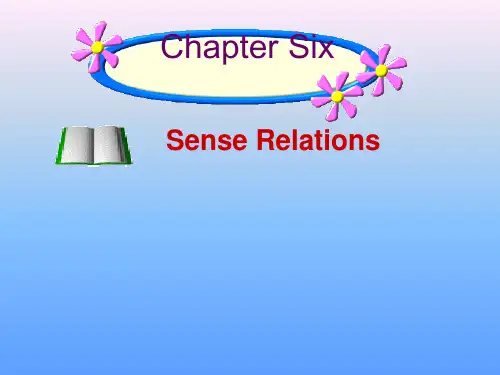
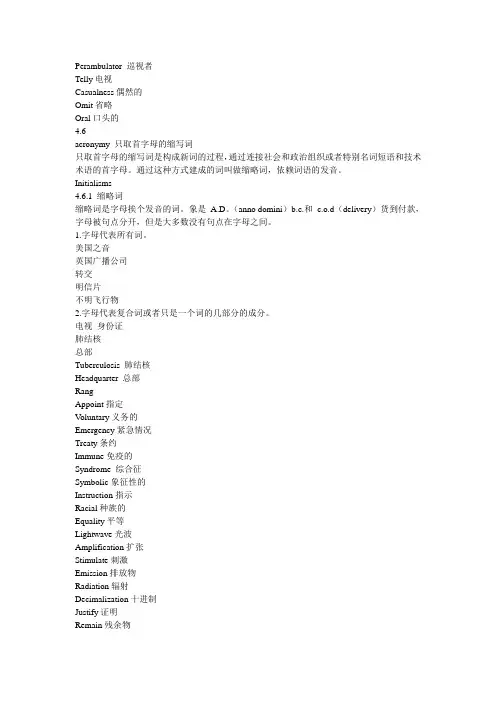
Perambulator 巡视者Telly电视Casualness偶然的Omit省略Oral口头的4.6acronymy 只取首字母的缩写词只取首字母的缩写词是构成新词的过程,通过连接社会和政治组织或者特别名词短语和技术术语的首字母。
通过这种方式建成的词叫做缩略词,依赖词语的发音。
Initialisms4.6.1 缩略词缩略词是字母挨个发音的词。
象是A.D。
(anno domini)b.c.和c.o.d(delivery)货到付款,字母被句点分开,但是大多数没有句点在字母之间。
1.字母代表所有词。
美国之音英国广播公司转交明信片不明飞行物2.字母代表复合词或者只是一个词的几部分的成分。
电视身份证肺结核总部Tuberculosis 肺结核Headquarter 总部RangAppoint指定V oluntary义务的Emergency紧急情况Treaty条约Immune免疫的Syndrome 综合征Symbolic象征性的Instruction指示Racial种族的Equality平等Lightwave光波Amplification扩张Stimulate刺激Emission排放物Radiation辐射Decimalization十进制Justify证明Remain残余物Contemporary同代的人Constituent成分Period句点4.6.2Acronyms首字母缩写词首字母缩写词是从首字母构成,但是发音是正常词,例如“雷达”(无线电探测和响铃)“义务女工”“艾滋病”(免疫匮乏综合征)“basic”(初学者多功能象征性指示码)“种族平等进程”“通过刺激辐射物排放导致的光波扩张”(激光)“英语教学”一些首字母缩写词是由第一词的首字母加上第二个整词构成,例如“核弹”“防御提示”“公务员”“十进制的日子”“胜利日”两种首字母缩写词在第二次世界大战以来已经变得非常流行并且因此极具活力。
这在etcrowley的缩写词字典中搜集的那样词的数量来证明。
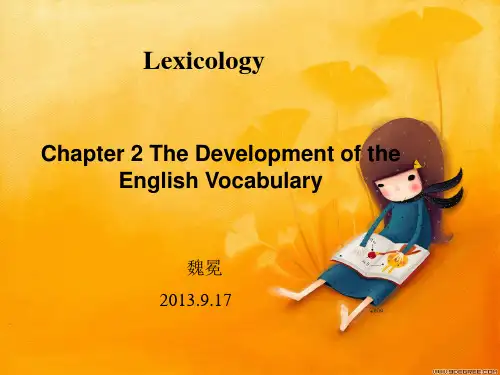
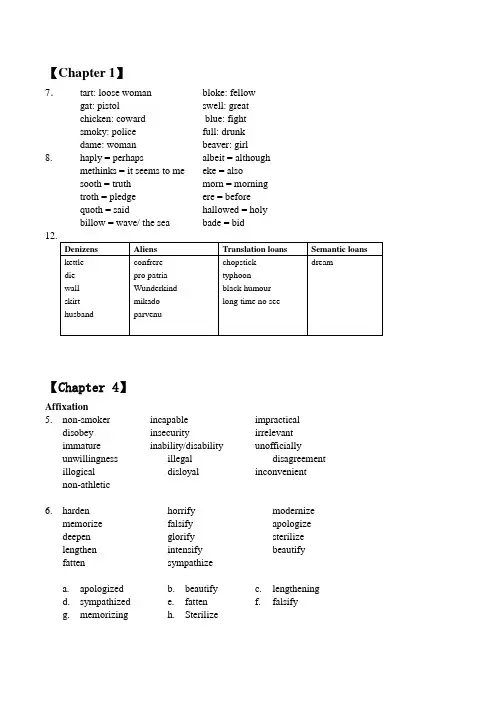
【Chapter 1】7.tart: loose woman bloke: fellowgat: pistol swell: greatchicken: coward blue: fightsmoky: police full: drunkdame: woman beaver: girl8. haply = perhaps albeit = althoughmethinks = it seems to me eke = alsosooth = truth morn = morningtroth = pledge ere = beforequoth = said hallowed = holybillow = wave/ the sea bade = bid12.Denizens Aliens Translation loans Semantic loanskettle die wall skirt husband confrerepro patriaWunderkindmikadoparvenuchopsticktyphoonblack humourlong time no seedream【Chapter 4】Affixation5. non-smoker incapable impracticaldisobey insecurity irrelevantimmature inability/disability unofficiallyunwillingness illegal disagreement illogical disloyal inconvenientnon-athletic6. harden horrify modernizememorize falsify apologizedeepen glorify sterilizelengthen intensify beautifyfatten sympathizea. apologizedb. beautifyc. lengtheningd. sympathizede. fattenf. falsifyg. memorizing h. Sterilize7. a. employee b. politician c. participantd. waitresse. conductorf. teacherg. pianist h. examinee/examiner8.trans- = across: transcontinental, trans-worldmono- = one: monorail, monoculturesuper- = over, above: superstructure, supernaturalauto- = self: autobiography, automobilesub- = bad, badly: malpractice, malnutritionmini- = little, small: minicrisis, miniwarpre- = before: prehistorical, preelectionex- = former: ex-teacher, ex-filmerCompoundingheartbeat [S + V] brainwashing [V + O]movie-goer [place + V] baking powder [ V +adv]far- reaching [V + Adv] dog-tired [adv + a]lion-hearted [adv + a] love-sick [adv + a]boyfriend [S + complement] peace-loving [V +O]snap decision [V + O] easy chair [ a + n]on-coming [V +adv] tax-free [adv +a]light-blue [a + a] goings-on [V +adv]4. well-bred/well-behaved culture-bound/homeboundneedle work/homework praiseworthy/respectworthybar-woman/sportswoman nation-wide/college-wideclear-minded/strong-minded military-style/newstyleself-control/self-respect budget-related/politics-relatedwater-proof/fire-proof once-fashionable/once-powerfulnews-film/news-letter mock-attack/mock-sadnesssister-in-law/father-in-law home-baked/home-producedhalf-way/half-done ever-lasting/ever-greenage-conscious/status-conscious campus-based/market-basedConversion7. a. stomach [n → v] b. room [n → v]c. wolf [n → v]d. come/go [v → n]e. fam iliar [a → n]f. innocent [a → n]g. flat [a → n]h. ah/ ouch [int → v]i. warm [a → n]j. has-been/might-have-been [finite v → n]k. Hamlet [proper n → v]l. buy [v → n]m. smooth [a → v]Blendingmotel (mo tor + ho tel)humint (hum an + int elligence) advertisetics (advertise ment + statis tics) psywarrior (psy chological warrior) hoverport (hover craft + port) chunnel (ch annel + t unnel) hi-fi (hi gh + fi delity) cinemactress (cinem a + actress) Clippingcopter (heli copter) dorm (dorm itory)lab (lab oratory) prefab (pref abricated house)gas (gas oline) prof (prof essor)scope (tele scope) champ (champ ion)sarge (serge ant) mike (mic rophone)ad (ad vertisement) tec (de tec tive)Acronymy2. kg = k ilo g ram ft = f oo t cf = c on f ercm = c enti m eter $ = dollaribid = ibid em etc. = et c eteraVIP = v ery i mportant p ersonOPEC = O rganization of P etroleum E xporting C ountriesTOEFL = t eaching o f E nglish as a f oreign l anguage3. a. SALT b. radar c. AIDS d. BASICe. Laserf. WHOg. sonarh. G-man Backformation2. lase (laser)escalate (escalator)babysit (babysitter)peeve (peevish)orate (orator)commute (commuter)Commonization of Proper Namesa. tantalize—Tantalusb. Argus-eyed—Argusc. narcissism—Narcissusd. sabotage—sabotse. martinet—Martinetf. yahoo—Yahoog. Shylock—Shylockh. hoovering—Hooveri. utopia—Utopiaj. Uncle Tommism—Uncle Tom6. apes—b birds—acattle—m cricket—ndoves—c foxes—jgeese—k sheep—fwolves—g monkeys—epigs—l hyenas—hturkeys—d swans—i9. a. A scientist working in a project to develop industrial uses for nuclear power might have allthe positive associations with “atomic”, such as “benefit, energy”, etc.b. A Japanese resident of Hiroshima, victim of the atomic explosion at the end of World War II, might have all the negative associations with “atomic”, such as “suffering, killing, death, horror", etc.c. To a student of nuclear physics, “atomic” might be associated with “mystery, science,knowledge”, etc.10. talkative: implying a fondness for talking frequently and at length (neutral)articulate: expressing oneself easily and clearly (positive)gossip: indulging in idle talk or rumours about others (negative)rambling: talking aimlessly without connection of ideas (negative)fluent: speaking easily, smoothly, and expressively (positive)mouthy: overtly talkative, especially in a rude way (nagative)11.No Appreciative Neutral Pejorative1 particular fastidious/fussy2 critical fault-finding/picky3 style/vogue fad4 artful cunning/sly5 unstable fickle/capricious6 developing underdeveloped/ backward7 encourage/ promote instigate8 group clique/gang14. bull [-HUMAN +MALE +ADULT +BOVINE]cow [-HUMAN -MALE +ADULT +BOVINE]calf [-HUMAN +MALE -ADULT +BOVINE]rooster [-HUMAN +MALE +ADULT +GALLINE]hen [-HUMAN -MALE +ADULT +GALLINE]chicken [-HUMAN +MALE +ADULT +GALLINE]-HUMANbull cow calf +BOVINErooster hen chicken +GALLINE+MALE -MALE +ADULTPolysemy4.a piece of timbertabledining table council tablefood served at the table; meal supplied by the week or monthcouncilors;committee;directors of acompany boardHomonymy4. 1) Make both ends meat is a parody of make both ends meet which means “haveenough money for one’s needs”. Here the butcher cleverly uses the pair ofhomonyms meat and meet to make a pun. It makes a proper answer to the lady’s question. (1) Butchers cannot make both ends meat (make whole sausages with all meat) because they cannot make both ends meet (If they made sausages with all meat, which is more costly, they would not earn enough money to survive.)( 2) Don’t complain. All the butchers do the same. I am not the only one who is making sausages with bread.2) Swallow is a bird which is seen in summer. But by one swallow we see, we cannot deduce that it is already summer time. Swallow can also mean a mouthful of wine. On a cold winter day, if one has a swallow of wine, one may feel warm.3) arms has two meanings: weapons; the human upper limbs. Since “a cannon ball took off his legs”, the soldier was not able to fight on, so he “laid down his arms”, which means “surrender”. It can also mean he laid down his upper limbs.Synonymy3. avaricious: greedycourteously: politelyemancipate: set freecustomary: usualwidth: breadthadversary: opponentgullible: deceivedremainder: residueinnocent: sinlessobstacle: obstructionvexation: annoyance5. a. identifiable b. safetyc. motivatesd. delicatee. surroundingsf. artificialg. prestige h. perspirei. accomplishment j. silentk. impressive l. evaporate6. run move spinturn whirl roll7. a. stead b. gee-gee c. riped. maturee. effectivef. efficientg. fatigued, children h. tired, kidsi. declined j. refused k. rancidl. addled m. Penalties n. fineso. rebuked p. accusedAntonymy5. a. similar/same b. safec. sharp/ smartd. sende. stingy/ selfish h. simplef. significant/sensible i. sureg. skeptical/ suspicious l. smoothj. slipshod/ slovenly/ sloppyk. sleepiness/ sleep / slumberm. subjectiven. sob/ scowl6. a. old-fashioned b. completelyc. moistured. speciale. essentialf. similarityg. innocent h. rigidi. loosen j. clarityk. deserted l. fruitfulm. peremptory n. depressedo. indifferent7. a. feed—starve, cold-fever b. wisdom—folliesc. haste—leisured. penny—pound, wise—foolishe. speech—silencef. absence—presenceg. admonish—praise i. wise men—foolsh. young—old private—public saint—devilj. mind—body k. foul—fairl. danger—security m. deliberate--promptn. children—parents o. bully—cowardp. head—tail8.right—wrong single—returndry—sweet hard—easystrong—faint rough—calmlight —dark cold —warm high —low/deep Hyponymy3. furniture: desk, chair, table, bedmatter: liquid, gas, solid meat: pork, beef, mutton go: run, fly, walk 4. profession workplacesurgeon: clinic, hospital plumber: house, building lawyer: office, law courts mechanic: garage photographer: studio foreman: worksite, factory5.6. In Sentence 1, got, furniture, recently are superordinates because they are general and convey a very vague idea whereas in Sentence 2, the three words are replaced respectively by bought, cupboard, three days ago , which are subordinates, conveying a definite and clear idea. So Sentence 2 is better than Sentence 1. In 3, it is said, magnificent building, destroyed, yesterday are superordinate terms, which are comparatively much more general than the news says, Royal Hotel, burnt down, last night respectively in 4, which can be described as subordinates. Since 4 is clearer than 3 in meaning, it is better.Semantic field3. Group 1 is synonymously semantic field and Group 2 is semantic filed . The difference lies: In 1 the words are synonyms , none of them covers the meaning of another, and they differ only in style and emotive values. In 2 the words are not synonyms, but each refers to a specific type of horse . Horse is a cover term or superordinate, and others are subordinates. These terms have no difference in style or affective meaning.BEDROOM mattress dressing gownclothes pyjamas carpetrug mirror comb hairbrush pillows sheetsblanketsleepersdressing tablewardrob bed4. 1) extension 2) extension3) narrowing 4) degradation5) elevation 6) narrowing7) extension 8) extension9) narrowing 10) elevation11) narrowing 12) degradation13) degradation 14) degradation5. a. associated transferb. abstract to concretec. abstract to concreted. abstract to concretee. abstract to concretef. abstract of concreteg. associated transferh. associated transferi. synesthesiaj. synesthesia6. a. objective b. subjective, objectivec. objectived. subjectivee. subjectivef. subjectiveg. subjective h. subjective, objective7. a. die b. graveyardc. bedlam疯人院d. old peoplee. strikef. Policemang. stupid pupil h. poor peoplei. toilet j. fat personk. unemployed mother2. a. to repairb. measurement and determination of one’s positionc. predicamentd. injectiona. a single complete dividing part (of a rocket)b. the theatre or acting as a professionc. a particular point or period in a process of developmentd. to plan, arrange and carry outa. interchange and discussion of ideas, esp. for mutual understanding orharmonyb. conversationc. a written conversation (of a play, etc.)3. a. synonymb. explanation/ definitionc. antonymd. examplee. relevant detailsf. relevant detailsg. relevant details4. a. stop people drinkingstop drinking by themselvesb. a stone house which is biga house built of big stonesc. a picture possessed by Bettya photograph of Bettyd. aunts who are visitingpaying a visit to auntse. take Jane as his wifepreside over Jane’s weddingf. a weapon that can fly over long distance and that it explodes when it h its thething it aims atan object that is thrown at somebody in order to hurt him6. a—2) b—9) c—3)d—6) e—1) f—8)g—5) h—4) i—7)j—10)7. a. stand out againstb. approve ofc. get … over withd. looking intoe. come up withf. comply withg. cashed in onh. go withouti. to profit by / fromj. dut down …to8. a cool cat = a really calm personblow one's stack = lose control over oneselffly off the handle = become excessively angrywhat's more = furthermoreget away with = commit an illegitimate act without penaltyof course = naturallyget on = get oldpepper and salt = grey (hair)make up for = compensate forlost time = time wastedtake it easy = relax, not worryget up = rise from bedturn in = go into bedtake care of = manage or look afterlike a breeze = without effort or easilytime off = time for restget it made = be successfulthis is it = be in a position or place, or have possession of an objectbeyond which more of the same is unnecessarySam is really a calm person. He never loses control of himself and hardly ever becomes too angry. Furthermore, he knows how to manage his business financially by using a few tricks…Needless to say, he, too, is getting older. His hair is beginning to turn grey, but he knows how to compensate for wasted time by relaxing. He rises early, exercises, and goes to bed early.He manages his frankfurter dispensary without visible effort, until it is someone else's turn to work there. Sam is successful, he has reached his life's goal.9. a. “Well, it's the old story of the stitch in t ime,” he said.A stitch in time saves nine.b. Fleur's head was lost in the tool-box, but her voice was heard saying: “Too many cooks,better let me.”Too many cooks spoil the broth.c. But not many other people held that view discerning his finger still very large in every pie— so much so that there often seemed less pie than finger.have a finger in the pied. I’m thinking of putting up a “Silence is golden” placard in his office. Nobody can hearthemselves think.Speech is silver, silence is golden.e. They four had one likeness: their appearance and their work was as it were a wheel in themiddle of a wheel.wheel within wheelsf. He quotes them extensively nevertheless, together with other equally suspect evidence,because otherwise he would have no straw with which to make his bricks.make bricks without straw10. wind and weather wheeling and dealingwaifs and strays town and gowntop and tail time after timerules and regulations rise and fallrags and tatters puff and blowpick and shovel peace and quietover and above one and onlyoff and on neck and neckshoulder to shoulder moan and groanmilk and water man and beast11. a. 好奇伤身。
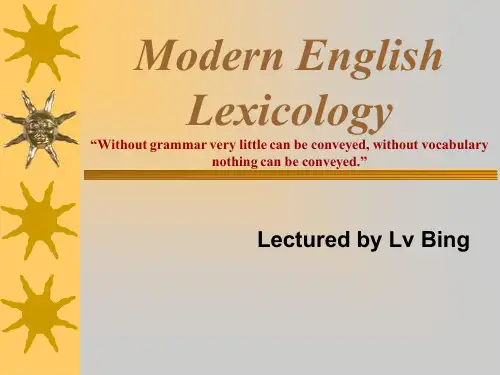
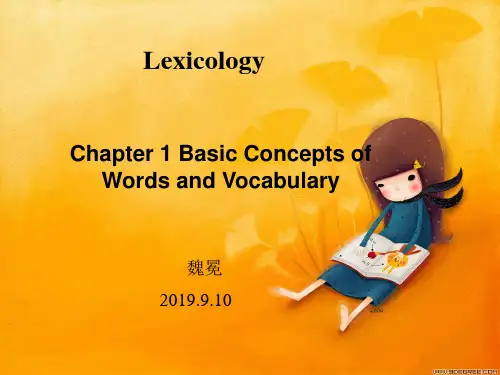
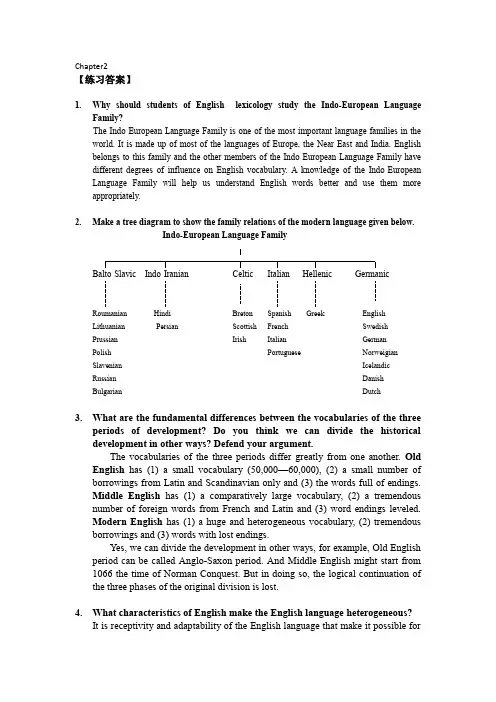
Chapter2【练习答案】1.Why should students of English lexicology study the Indo-European LanguageFamily?The Indo-European Language Family is one of the most important language families in the world. It is made up of most of the languages of Europe, the Near East and India. English belongs to this family and the other members of the Indo-European Language Family have different degrees of influence on English vocabulary. A knowledge of the Indo-European Language Family will help us understand English words better and use them more appropriately.2.Make a tree diagram to show the family relations of the modern language given below.Indo-European Language FamilyBalto-Slavic Indo-Iranian Celtic Italian Hellenic GermanicRoumanian Hindi Breton Spanish Greek EnglishLithuanian Persian Scottish French SwedishPrussian Irish Italian GermanPolish Portuguese NorweigianSlavenian IcelandicRussian DanishBulgarian Dutch3.What are the fundamental differences between the vocabularies of the threeperiods of development? Do you think we can divide the historical development in other ways? Defend your argument.The vocabularies of the three periods differ greatly from one another. Old English has (1) a small vocabulary (50,000—60,000), (2) a small number of borrowings from Latin and Scandinavian only and (3) the words full of endings.Middle English has (1) a comparatively large vocabulary, (2) a tremendous number of foreign words from French and Latin and (3) word endings leveled.Modern English has (1) a huge and heterogeneous vocabulary, (2) tremendous borrowings and (3) words with lost endings.Yes, we can divide the development in other ways, for example, Old English period can be called Anglo-Saxon period. And Middle English might start from 1066 the time of Norman Conquest. But in doing so, the logical continuation of the three phases of the original division is lost.4.What characteristics of English make the English language heterogeneous?It is receptivity and adaptability of the English language that make it possible forEnglish to borrow heavily from other major languages of the world, so that the English vocabulary eventually has become heterogeneous.5.Account for the popularity of English in the present world from a linguisticperspective.The popularity of English lies in the fact that English is ready to borrow from other languages and to adapt itself to new situations and new developments, that it has accepted elements from all other major languages and that it has simple reflection and a relatively fixed word order. All these make the language comparatively easy to learn and to use.6.Here is a text chosen from the Declaration of Independence.When in the course of human events, it becomes necessary for one people to dissolve the political bonds which have connected them with another, and to assume among the powers of the earth separate and equal station to which the laws of nature and of nature's God entitle them, a decent respect to the opinions of mankind requires that they should declare the causes which impel them to the separation.Pick out all the words of Greek or Latin origin from the text and see of what origin are the words left. What insight does this exercise give you with reference to the borrowings from Greek and Latin?course human events necessary peopledissolve political connected assume separateequal station nature entitle decentrespect opinions requires declare causesimpel separationFrom the words picked out, we can see that most of the content words are either of Greek or Latin origin. What are left are mostly functional words. This shows that Greek and Latin play a very important part in the English vocabulary.7.Give a brief account of the four phases of Latin borrowing with two or threeexamples.Latin borrowing can be divided into four phase: (1) Pre-Anglo-Saxon period, (2) Old English period, (3) Middle English period and (4) modern English period.Borrowings in the first period are mainly common words such as wall, wine, kettle and so on; words borrowed in the second period are mainly religious terms such as candle, nun, church; the third period saw words borrowed often via French such as frustrate, history, infancy and so on and in the four period words borrowed from Latin are usually abstract formal terms like status, nucleus, minimum.8.Tell the different elements that make up the following hybrids.eventful [Latin + English]hydroplane [Greek + Latin]falsehood [ Latin + English]pacifist [Latin + Greek]saxophone [German + Greek]heirloom [ French + English]joss house [ Portuguese + English] television [Greek + Latin]9.Put the following French loan words into two groups, one being earlyborrowings and the other late ones.amateur (late)finacé (late)empire (early)peace (early)courage (early)garage (late)judgement (early)chair (early)chaise (late)grace (early)servant (early)routine (late)jealous (early)savaté (late)genre (late)gender (early)début (late)morale (late)state (early)chez (late)ballet (late)ment on Jespersen’s remark on Scandinavian element in English ‘AnEnglishman cannot thrive or be ill or die without Scandinavian words; they are to the language what bread and eggs are to the daily fare’.Jespersen’s comment reveals the importance of Scandinavian words in English.Just as people cannot live without bread and eggs, so English language cannot operate properly without Scandinavian words.11.Match the Italian musical terms with the proper definitionsallegro, f轻快andante, j 行板diminuendo, g 渐弱largo, d 缓慢pianoforte, a轻转慢alto, i女低音crescendo, b渐强forte, e强piano, h轻soprano, c女高音12.Look up these words in a dictionary to determine the language from whicheach has been borrowed.cherub (Hebrew) snorkel (G)coolie (Hindi)tulip (Turk)lasso (Sp)wok (Ch)shampoo (Hindi)chocolate (Mex)tepee (AmInd)jubilee (Gr)kibitz (G)Sabbath (Heb)chipmunk (AmInd)tamale (Mex)cotton (Arab)voodoo (Afr)loot (Hindi)sauerbraten (G)13.Here is a menu of loan words from various sources. Choose a word to fill ineach space.a. alligatorb. lococ. rodeod. bonanzae. igloof. blitzkriegg. wigwam h. canoei. hurricane j. boomerangk. panchos14.Describe the characteristics of the contemporary vocabulary.The characteristics of the contemporary vocabulary can be summarized as follows: (1) the vocabulary is huge in size and heterogeneous; (2) it has tremendous borrowings from all major languages of the world; (3) the words have lost most of their endings; (4) it is growing swiftly by means of word-formation because of the development of science and technology, social, economic and political changes and influence of other cultures and languages.15.What are the major modes of vocabulary development in contemporaryEnglish?The major modes of vocabulary development of contemporary are creation, that is means of word-formation; semantic change, adding new meanings to old words; borrowing words from other languages and revival or old-fashioned words, which has a insignificant role.【练习答案】1.Write the terms in the blanks according to the definitions.a. morphemeb. allomorphc. bound morphemed. free morphemee. affixf. informational affixg. derivational affix h. rooti. stem j. base2.What is the difference between grammatical and lexical morphemes, and inflectionaland derivational morphemes? Give examples to illustrate their relationships.Inflectional morphemes are the suffixes added to the end of words to denote grammatical concepts such as -s(-es), -ed, -ing and -est(to show superlative degree of adjectives and adverbs) whereas derivational morphemes are prefixes and suffixes added to words to form new words such as pre-, dis-, un-, -tion, -er, -ness and so on.Grammatical morphemes are those used to show grammatical concepts, including reflectional suffixes as mentioned above and functional words (prepositions, pronouns, articles, auxiliary verbs), for example, but, the, do and was; lexical morphemes are derivational affixes including both prefixes and suffixes.3. Analyse the words in terms of root, stem and base.individualisticindividualist + ic [stem, base]individual + ist [stem, base]individu + al [stem, base]in + dividu [root, stem, base]undesirablesun + desirable [stem, base]desir + able [root, stem, base]anize the following terms in a tree diagram to show their logical relationships.free morpheme = free rootmorpheme bound rootbound morpheme inflectional affixaffix prefixderivational affixsuffix【练习答案】Enumerate the three important means of word formation and explain their respective role in the expansion of English vocabulary.The three important means of word formation are affixation, which creates 30-40% of the total number of new words; compounding, which brings 28-30% of all the new words; and conversion which provides English with 26% of the new words. Affixation1.What is affixation? What is its alternative name?Affixation, also called derivation, is the formation of new words by adding affixes to stems. Affixation includes prefixation and suffixation according to the type of affixes used to form new words.2.What is the difference between prefixation and suffixation?Prefixation is to create new words by adding prefixes to bases and suffixation makes new words by adding suffixes to bases.3.What are the characteristics of prefixes and suffixes?Generally speaking, prefixes do not change part of speech of bases but their meaning whereas suffixes do change part of speech but modify the meaning of bases.4.What is the best way to classify prefixes? Why?The best way to classify prefixes is on the basis of meaning because prefixes change the meanings of bases only in general.5.Form negatives with each of the following words by using one of theseprefixes dis-, il-, im-, in-, ir-, non-, un-.non-smoker incapable impracticaldisobey insecurity irrelevantimmature inability/disability unofficiallyunwillingness illegal disagreementillogical disloyal inconvenientnon-athletic6.Turn the following nouns and adjectives into verbs with -en, -ify, -ize andthen choose them to fill in the blanks in the sentences that follow.harden horrify modernizememorize falsify apologizedeepen glorify sterilizelengthen intensify beautifyfatten sympathizea.apologizedb.beautifyc.lengtheningd.sympathizede.fattenf.falsifyg.memorizing h.Sterilize7.Each of the following sentences contains a word printed in italics. Completethe sentence by using this word to form a noun to refer to a person.a.employeeb.politicianc.participantd.waitresse.conductorf.teacherg.pianist h.examinee/examiner8.Match Column A with Column B and give two examples for each.trans- = across: transcontinental, trans-worldmono- = one: monorail, monoculturesuper- = over, above: superstructure, supernaturalauto- = self: autobiography, automobilesub- = below: subculture, subconsciousmal-= bad, badly: malpractice, malnutritionmini- = little, small: minicrisis, miniwarpre- = before: prehistorical, preelectionex- = former: ex-teacher, ex-filmerCompounding1.What are the criteria by which to differentiate compounds from free phrases?What do you think of these criteria?The three criteria are (1) stress pattern, that is stress in a compound falls on the first element but on the second in a free phrase, e.g. `--(compound), -` -(free phrase); (2) meaning, that is the meaning of a compound is usually not the combination of the meanings of the component parts, but the free phrase is, e.g.hot line (compound: busy line), hot potato (free phrase: potato which is hot); (3) grammatical unity, that is the different elements form a grammatical unit, which does not allow internal change, e.g. easy chair (compound: a special arm chair), easier chair (free phrase: a less easy chair).However, every rule has exception. The same is true of the criteria. There are examples against each of the three rules.2.Analyse the following compound words and explain their internalgrammatical relationship.heartbeat [S + V]brainwashing [V + O]movie-goer [place + V]baking powder [ V +adv]far- reaching [V + adv]dog-tired [adv + a]lion-hearted [adv + a]love-sick [adv + a]boyfriend [S + complement]peace-loving [V +O]snap decision [V + O]easy chair [ a + n]on-coming [V +adv]tax-free [adv +a]light-blue [a + a]goings-on [V +adv]3.What are the usual methods to form compound verbs? Give examples.There two ways to form verb compounds. For example, first name (v from first name), honeymoon(v from honeymoon) are words created by means of conversion; words such as proofread (v from proofreading) and chain-smoke (v from chain smoker) are formed by means of backformation.4.Form compounds using the following either as the first or the second element ofthe compound as indicated and translate the words into Chinese.well-bred有教养的well-behaved守规矩的culture-bound含文化的homebound回家的needle work针织品homework家庭作业praiseworthy值得表扬得respectworthy值得尊敬的bar-woman吧女sportswoman运动员nation-wide全国的college-wide全校的clear-minded头脑清晰的strong-minded意志坚强的military-style军事风格的newstyle新款self-control自制self-respect自尊budget-related有预算的politics-related与政治相关的water-proof防水fire-proof放火once-fashionable曾经流行的once-powerful曾经强大的news-film新闻片news-letter实事通讯mock-attack演习mock-sadness假悲伤sister-in-law嫂/弟媳妇father-in-law岳父/公公home-baked自家烤的home-produced自制的half-way半途/半道half-done半生不熟ever-lasting永久ever-green常青age-conscious年龄敏感的status-conscious身份敏感campus-based以校园为基地的market-based基于市场的Conversion1.What is conversion? What do you think of the alternatives functional shiftand zero-derivation?Conversion is to use words of one part of speech as those of another part of speech. The term functional shift reveals the actual function of conversion, i.e.change of the functions of words. The term zero-derivation approaches conversion from the perspective of derivation because it is a way of deriving new words by adding zero affixes, hence zero derivation.2.In what way is conversion different from suffixation?Although both are called derivation, suffixation is the derivation of new words by adding suffixes to bases, such as simple (adj) → simpli fy (v) whereas conversionis the derivation of new words by adding zero affixes, such as single (adj) → single(v).3.What classes of words are most frequently converted?The classes frequently involved in conversion are nouns, verbs and adjectives. 4.In what way are verbs converted from nouns semantically related to theoriginal nouns and versa?Verbs converted to nouns usually are related to the original verbs in six different ways. The new nouns converted from verbs refer to (1) state of mind or sensation, e.g. desire(state of desiring); (2) event or activity, e.g. swim(the activity of swimming) ; (3) result of the action, e.g. buy (the result of buying); (4) doer of the action, e.g. bore (the person who bores); (5) tool or instrument, e.g.paper (doing something with paper) and (6) place, e.g. turn (the place of turning).Nouns converted to verbs are generally related to the original nouns in seven different ways. The new verbs usually mean (1) to put in or on the noun, e.g.bottle (to put into the bottle); (2) to give the noun or provide with the noun, e.g.finance(to provide with finance); (3) to remove the noun from, e.g. peel(to remove the peel from); (4) to do with the noun, e.g. shoulder (to do something with shoulder); (5) to be or act as the noun, e.g. tutor (to be the tutor); (6) to make or change into the noun, e.g. cash (to change into cash) and (7) to send or go by the noun, e.g. ship (to send by ship).5.Explain partial conversion and full conversion with examples.When adjectives are converted into nouns, .some are completely changed, thus known as full conversion, and others are partially changed, thus known as partial conversion. Adjectives which are fully converted can achieve a full noun status, e.i. having all the characteristics of nouns. That is they can take a/an or-s/-es to indicate singular or plural forms: a native, a Republican, a pair of shorts, finals. Adjectives which are partially converted still keep adjective features. They should always be used with the, and they cannot take -s/-es to show plural forms. Moreover, the words can have comparative or superlative degrees: the poor, the poorer, the young, the very unfortunate.6.What changes are occasionally involved in the process of conversion?The changes occasionally involved are (1) change of spelling accompanied by pronunciation, e.g. life /laif/ → live /liv/, breath /breθ/ → breathe /bri:ð/ and blood /bl∧d→bleed/bli:d/; (2) change of pronunciation and stress, e.g. use n /ju:s/→ use v/ju:z/ and permit n /`pə:mit/ → v /pə`mit/ and so on.7.Pick out the words which you think are converted in the following sentencesand tell how they are converted.a.stomach [n → v]b.room [n → v]c.wolf [n → v]e/go [v → n]e.familiar [a → n]f.innocent [a → n]g.flat [a → n]h. ah/ ouch [int → v]i.warm [a → n]j.has-been/might-have-been [finite v → n]k.Hamlet [proper n → v]l.buy [v → n]m.smooth [a → v]BlendingAnalyse the blends and translate them into Chinese.motel (mo tor + ho tel)汽车旅馆humint (hum an + int elligence)情报advertisetics (advertise ment + statis tics)广告统计学psywarrior(psy chological warrior)心理战专家hoverport (hover craft + port)气垫船码头chunnel (ch annel + t unnel) 海峡隧道hi-fi (hi gh + fi delity) 高保真音响cinemactress (cinem a + actress)电影演员ClippingRestore the full forms of the following words and see how these slipped words are formed.copter (heli copter)front clippingdorm (dorm itory)back clippinglab (lab oratory)back clippingprefab (prefab ricated house)phrase clippinggas (gas oline)back clippingprof (prof essor) back clippingscope (tele scope)front clippingchamp (champ ion)back clippingsarge (serge ant)back clippingmike (mic rophone)back clippingad (ad vertisement)back clippingtec (de tec tive)front and back clippingAcronymy1.Both initialisms and acronyms are formed to a certain extent from initialletters. Is there any difference between them? Illustrate your point with examples.Yes, there is difference between them. The difference lies in the formation and pronunciation. Initialisms are formations pronounced letter by letter, e.g. UFO /ju:efou/ (unidentified flying object), BBC /bi:bi:ci:/ (British Broadcasting Corporation), VIP /vi:aipi:/ (very important person) and acronyms are formed to conform to the rule of spelling and pronunciation, that is the words look and sound like ordinary words, e.g. AIDS/`eiz/ (a cquired i mmune d eficiency s yndrome) , MAD/mæd/ (m utually a ssured d estruction), radir/`neidə/ (ra diod etecting a nd r anging).2.What do the short forms stand for?kg = k ilo g ram ft = f oo t cf = c on f ercm = c enti m eter$ = dollar ibid = ibid emetc. = et c etera VIP = v ery i mportant p ersonOPEC = O rganization of P etroleum E xporting C ountriesTOEFL = t eaching o f E nglish as a f oreign l anguage3.Choose a word from the list to fill each of the blanks.a. SALTb. radarc. AIDSd. BASICe. Laserf. WHOg. sonar h. G-manBackformation1.Both back-formation and back-clipping are ways of making words byremoving the endings of words. How do you account for the coexistence of the two? Can you illustrate the difference?It is true that both are means of making new words by removing the end part of the words. But they have difference. For a back-formed word, what is removed is supposed to be the suffix, e.g. auth← auth or, donate← donat ion, loaf← loaf er, the forms -or, -ion, -er coincide with the three suffixes. For back clipping, however, what is removed is usually difference from the existing suffixes, e.g.ad← ad vertisement, gas ← gas oline, exam ← exam ination, etc.2.Give the original words from which the following words are back-formed.lase (laser)escalate (escalator)babysit (babysitter)peeve (peevish)orate (orator)commute (commuter)Commonization of Proper NamesStudy the following sentences and pick out the words which used to be proper names and explain the meanings in relation to their origins.a. tantalize—Tantalus: to tease or torment by keeping sth. wanted out of reachb. Argus-eyed—Argus: to be extremely watchfulc. narcissism—Narcissus: excessive admiration of oneself or one’s appearanced. sabotage—sabots: (1) to destroy or damage deliberately;(2) deliberate damage or destructione. martinet—Martinet: strict/stern (military) trainerf. yahoo—Yahoo: a lout or ruffiang. Shylock—Shylock: a ruthless money lenderh. hoovering—Hoover: cleaning by using a vacuum cleaneri. utopia—Utopia: an imaginary place of ideal perfectionj. Uncle Tommism—Uncle Tom: behaving subserviently to whitesChapter 5【练习答案】1.What is reference?Reference is the connection between the word form and what the form refers to in the world.2.What is concept?Concept is a notion or idea, formed in the mind as a result of cognition, which reflects the objective world.3.What is sense?The sense of a word shows its place in a system of semantic relationships with other words in the language. It is often used to substitute meaning.4.What is motivation? Does this theory contradict the theory of ‘arbitrariness’and ‘conventionality’ concerning the relationship between linguistic symbols and their senses?Motivation explains the relationship between the linguistic symbol and its meanings, or the logical reason why a certain word has a certain meaning.As mentioned earlier, the relationship between sound and meaning is arbitrary and conventional. Motivation seems to contradict the definition. The answer is ‘yes and no’. By ‘yes’, we mean all the mono-morphemic words in a language are non-motivated except a few onomatopoeic words which imitate the natural noises. By no, we mean all the multi-morphemic words are motivated, for in many cases the meaning of the whole word is the combination of the morphemes. The morphemic structure explains the meaning.5.What are the four types of motivation? Explain them with examples.The four types of motivation are onomatopoeic motivation, morphological motivation, semantic motivation and etymological motivation. Onomatopoeic motivation explains onomatopoeic words whose meaning is based on the pronunication of the words such as mieow, thump, peng etc.; morphological motivation explains the words whose morphological structure throws light on their meaning, such profiteer(profit + eer), darkroom(dark + room), deconstruction(de + construct + ion), etc.; semantic motivation explains the figurative meaning of words whose literal meaning suggests the figurative meaning such as the tongue of fire, the mouth of the river, the face of the earth;etymological motivation explains the words whose meaning is closely related to their origins such as banting (therapy for keeping slim by going on a diet discovered by Doctor Banting) and Brille (language used by the blind created by Brille).6.Match the words in Column A with those in column B.apes—gibber birds—sing/twittercattle—low crickets-chirpdoves—coo foxes—yelpgeese—gabble sheep—bleatwolves—howl monkeys—chatterpigs—grunt hyenas—laughturkeys—gobble swans—cry7.What is the difference between grammatical meaning and lexical meaning?Grammatical meaning refers to the part of meaning which shows grammatical relationship such as part of speech of words, plural forms of nouns, tense of verbs, etc. and lexical meaning includes all the rest of the meanings of a word apart from the frammatical meaning, i.e. conceptual meaing and associative meaning.8.What are the characterisitics of conceptual meaning and associative meaning?Conceptual meaning is fundamental, universal and stable whereas assocaitive meaning is secondary, contextual, open-ended or indeterminate, thus changing.9.What connotations do you think the word atomic nmight have for each of thefollowing people?a. A scientist working in a project to develop industrial uses for nuclearpower might have all the positive a ssociations with “atomic”, such as“benefit, energy”, etc.b. A Japanese resident of Hiroshima, victim of the atomic explosion at the endof World War II, might have all the negative associations with “atomic”, such as “suffering, killing, death, horror", etc.c.To a student of nuclear physics, “atomic” might be associated with “mystery,science, knowledge”, etc.10.All the words talkative, articulate, gossip, garrulous, rambling, fluent, gabby,mouthy can be describe a person’s ability of speech. What impression do you obtain of the person with the use of each of the words?talkative: implying a fondness for talking frequently and at length (neutral)articulate: expressing oneself easily and clearly (positive)gossip: indulging in idle talk or rumours about others (negative)garrulous: talking too much about trivial things (somewhat negative)rambling: talking aimlessly without connection of ideas (negative)fluent: speaking easily, smoothly, and expressively (positive)gabby: inclined to chatter (neutral)mouthy: overtly talkative, especially in a rude way (nagative)11.Put the following groups of words under Appreciative, Neutral and Pejorative.12.What are semantic features?Semantic features are the minimal semantic components of words which are abstracted from the words. These features are used to describe the sense of each words.13.What are the merits and demerits of componential ananlysis?Componential anaysis (CA) is useful mainly in three aspects. First, Componential anaysis reveal the semantic features of the sense of a word and helps one grasp the conceptual meaing of the word. Second, CA can help show the synonymy of two words by revealing their same components. Third, CA can help tell whethera collocation or syntactic structure is acceptable or not.However, problems are obvious. First, CA is appliable only to concrete words which have definite referents, but not to abstract words or words expressing abstract ideas or concepts. Second, CA is useful in revealing the conceptual meaning, but helpless in showing the figurative meaning of words. 14.Try to analyse the following words in terms of semantic opposition [±HUMAN],[±MALE], [±ADULT], [±BOVINE], [±GALLINE].bull[-HUMAN+MALE+ADULT+BOVINE]cow[-HUMAN-MALE+ADULT+BOVINE]calf[-HUMAN±MALE-ADULT+BOVINE]rooster[-HUMAN+MALE+ADULT+GALLINE]hen[-HUMAN-MALE+ADULT+GALLINE]chicken[-HUMAN±MALE±ADULT+GALLINE]Chapter 6【单元练习答案】Polysemy1.What is polysemy?Polysemy is a sense relation that deals with words of more than one meaning.It is the result of semantic change.2.When a word is created, it is monosemous. Then how does the word acquireits new meanings and become polysemous? Illustrate your point with examples.Take “neck” for example. It has five senses: (1) that part of a man or animal joining the head to the body;(2) that part of the garment;(3) the neck of an animal used as food;(4) a narrow part between the head and body or base of any object;(5) the narrowest part of anything.Of these five meanings,(1)is the meaning given to the word when it was created and all the rest were derived later on in the process of development.3.What is the fundamental difference between radiation and concatenation?A word develop its meaning through the process of either radiation orconcatenation, and in many cases, of both.Radiation is a semantic process which shows that the primary meaning and。
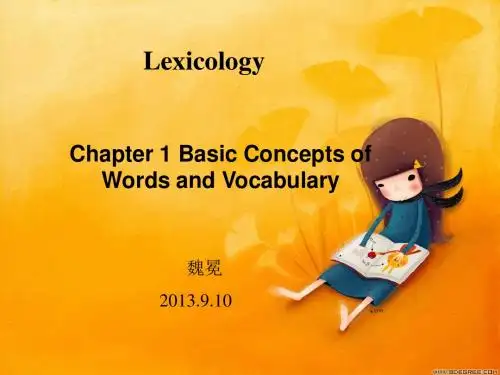
现代英语词汇学(课后总结中文)第一篇:现代英语词汇学(课后总结中文)第一章一个词可以被定义为一个基本单位的言论和作为一个最低的自由形式。
它是一个统一的声音和意义,帽子能够执行一个给定的句法功能,所有的话在一个语言的共同组成的词汇。
英语的历史发展表明,英语是一个沉重的借用者,它采用了几乎所有已知语言的词汇,尤其是拉丁语、法语和希腊语。
第一次世界大战的英语词汇¬拉里扩大的速度比以前快后渣土。
对了一天英语词汇快速增长的根本原因是科学技术进步的标志,社会经济、政治和文化的变化¬宝在英语母语国家的发生,和其他国家的语言和文化的强烈影响,由于在历史发展过程中出现大规模借贷,英语词汇极其丰富和异质。
词汇量从旧英语的50000个增加到了60000个,增加到了世界上最大的一百万个单词。
尽管外来词在本土词汇上占优势,但后者却是英语词汇中最熟悉、最有用的部分。
前者增加了灵活性和语言资源¬丰满。
英语词汇包含不同种类的词汇。
可根据不同的¬租金标准分类。
词汇可以根据其来源分类为母语反借词。
通过使用水平,词可以分为普通(或流行〉词文学的话口语词、俚语和术语。
一个词的状态不是固定不变的,而是不断变化的。
技术术语可能会很流行,而流行词可以用作专门术语。
一些俚语也成为常用词或俗语词可以分为实词和虚词前有独立的词汇意义,后者,在大多数情况下,没有词汇本身的含义,作为语法信号显示内容之间的连接词。
虚词比内容词少得多,但使用频率更高。
第二章词是由语素构成的,语素是英语最有意义的单位,既有音也有义。
一位是任何一个рЬешеMOR的变体形式。
语素111ay被归类为自由或束缚,自由语素是一个可以成为一个独立的COM¬完整的话语,而粘着语素不能单独存在;它必须出现至少一个其他语素自由或束缚。
语素可以分为根和根进行affixies,在аіягогсІ意义的重要组成部分,根可以免费或黏着语素自由根可以独立成为单词,并为语言的形成提供基础。
《英语词汇学教程》(2004年版)练习答案【Chapter1】7.tart:loose woman bloke:fellowgat:pistol swell:greatchicken:coward blue:fightsmoky:police full:drunkdame:woman beaver:girl8.haply=perhaps albeit=althoughmethinks=it seemsto me eke=alsosooth=truth morn=morningtroth=pledge ere=beforequoth=said hallowed=holybillow=wave/the sea bade=bid12.Denizens Aliens Translation loans Semantic loanskettle diewall skirt husband confrerepro patriaWunderkindmikadoparvenuchopsticktyphoonblack humourlong time no seedream【Chapter2】Ex.1The Indo-European Language Family is one of the most important language families in the world.It is made up of most of the languages of Europe,the Near East and India.English belongs to this family and the other members of the Indo-European have more or less influence on English vocabulary.A knowledge of the Indo-European Language Family will help us understand English words better and use them more appropriately.2.Indo-EuropeanLanguageFamilyBalto-Slavic Indo-Iranian Celtic Italian Hellenic GermanicRoumanian Hindi Breton Spanish Greek EnglishLithuanian Persian Scottish French SwedishPrussian Irish Italian GermanPolish Portuguese NorweigianSlavenian IcelandicRussian DanishBulgarian Dutch6.When in the course of human events,it becomes necessary for one people to dissolve the political bonds which have connected them with another,and to assume among the powers of the earth separateand equal station to which the laws of nature and of nature's God entitle them,a decent respect to the opinions of mankind requires that they should declare the causes which impel them to the separation.Most of the content words are either of Greek or Latin origin.What are left are mostly functional words.This shows that Greek and Latin play a very important part in the English vocabulary.8.eventful[Latin+English]hydroplane[Greek+Latin]falsehood[Latin+English]pacifist[Latin+Greek]saxophone[German+Greek]heirloom[French+English]joss house[Portuguese+English]television[Greek+Latin]9.amateur(late)finacé(late)empire(early)peace(E)courage(E)garage(L)judgement(E)chair(E)chaise(L)grace(E)servant(E)routine(L) jealous(E)savaté(L)genre(L) gender(E)début(L)morale(L) state(E)chez(L)ballet(L) 11.allegro,f轻快andante,j行板diminuendo,g渐弱largo,d缓慢pianoforte,a轻转慢alto,i女低音crescendo,b渐强forte,e强piano,h轻soprano,c女高音12.cherub(Hebrew)snorkel(G)coolie(Hindi)tulip(Turk)lasso(Sp)wok(Ch)shampoo(Indian)chocolate(Mex)tepee(Am Ind)jubilee(Gr)。
英语语音实用教程张维友课后答案1、Julia’s on holiday in Shanghai _______. [单选题] *A. in a momentB. after a momentC. at the moment(正确答案)D. at any moment2、We need a _______ when we travel around a new place. [单选题] *A. guide(正确答案)B. touristC. painterD. teacher3、( ) What she is worried __ is ____ her daughter is always addicted to chatting online./; that [单选题] *A /; thatB of thatC about that(正确答案)D about what4、Actually, we don't know whether this news comes from a reliable()or not. [单选题] *A. source(正确答案)B. originC. basisD. base5、We’re proud that China _______ stronger and stronger these years. [单选题] *A. will becomeB. becameC. is becoming(正确答案)D. was becoming6、I _______ no idea of where the zoo is. [单选题] *A. thinkB. getC. have(正确答案)D. take7、He has two sisters but I have not _____. [单选题] *A. noneB. someC. onesD. any(正确答案)8、( ). The old man enjoys ______ stamps. And now he has1300 of them [单选题] *A. collectB. collectedC. collecting(正确答案)D. to collect9、—Why do you call him Mr. Know?—______ he knows almost everything that we want to know.()[单选题] *A. SoB. OrC. ButD. Because(正确答案)10、72.—? ? ? ? ? ? ? ? ? ? ? ??—Yes, please. I want a sweater. [单选题] *A.How muchB.Can I help you(正确答案)C.Excuse meD.What will you take11、_____how to do with the trouble of the computer, Tom had to ask his brother for help. [单选题] *A.Not to knowB.Not knowing(正确答案)C.Not knownD.Not know12、It is reported that the fire caused serious()to that school building. [单选题] *A. damage(正确答案)B. destroyC. harmD.hurt13、( ) ________ large the library is! [单选题] *A. WhatB. What aC. How(正确答案)D. How a14、He studied harder to _______ his reading skills. [单选题] *A. improve(正确答案)B. rememberC. memorizeD. forget15、6.Hi, boys and girls. How are you ________ your posters for the coming English Festival at school? [单选题] *A.getting onB.getting offC.getting with (正确答案)D.getting16、You needn’t _______ me. I’m old enough to take care of myself. [单选题] *A. worry about(正确答案)B. write downC. put awayD. wake up17、I have seldom seen my father()pleased with my progress as he is now. [单选题] *A. so(正确答案)B. veryC. tooD. rather18、I don’t like playing chess. It is _______. [单选题] *A. interestingB. interestedC. boring(正确答案)D. bored19、His handwriting is better than _____. [单选题] *A. mine(正确答案)B. myC. ID. me20、It is my _______ to meet you here. [单选题] *A. pleasure(正确答案)B. pleaseC. pleasedD. pleasant21、Just use this room for the time being ,and we’ll offer you a larger one _______it becomes available [单选题] *A. as soon as(正确答案)B unless .C as far asD until22、Tom and Mary's house bought last year is()Lucy, s. [单选题] *A. the three size ofB. three times the size of(正确答案)C. as three times large asD. three times as larger as23、Can you tell me how the accident _______? [单选题] *A. came about(正确答案)B. came backC. came downD. came from24、Nick has always been good _______ finding cheap flights. [单选题] *A. at(正确答案)B. forC. withD. to25、There is _______ meat in the fridge.Lets go and buy some. [单选题] *A. little(正确答案)B. a littleC. fewD. a few26、86.—? ? ? ? ? ? ?will it take me to get to the Golden Street?—About half an hour. [单选题]* A.How farB.How long(正确答案)C.How oftenD.How much27、_____, Martin can reach the branch of that tall tree at the gate. [单选题] *A. As a short manB. Being shortC. As he is shortD. Short as he is(正确答案)28、35.Everyone in China ______ Mid-Autumn Day. [单选题] *A.likes(正确答案)B.likeC.is likingD.are like29、We sent our children to school to prepare them for the time _____ they will have to work for themselves. [单选题] *A. thatB. when(正确答案)C. whileD. as30、Although the story is written for children, it can be read by adult, _____. [单选题] *A. alsoB. eitherC. as wellD. too(正确答案)。
《英语词汇学》课后练习英语词汇学一、单项选择题1. According to semanticists, a word is a unit of ______.A. soundsB. meaningC. formD. function【正确答案】 B2. A word is a ______ that stands for something else in the world.A. symbolB. systemC. structureD. pattern【正确答案】 A3. We consider that the written form of a natural language is the written record of the ______ form.A. writerB. practicalC. oralD. grammatical【正确答案】 C4. In spite of the differences, at least ______ percent of the English words fit consistent spelling patterns.A. sixtyB. seventyC. eightyD. ninety【正确答案】 C5. Words may fall into content words and functional words by ______.A. use frequencyB. notionC. originD. stability【正确答案】 B6. Among the feature of words of the basic word stock, ______ is the most important one that may differentiate words of common use from all others.A. all national characterB. stabilityC. productivityD. collocability【正确答案】 A7. ______ belong to the sub-standard language, a category that seems to stand between the standard general words including informal ones available to everyone and in-group words.A. JargonsB. SlangsC. ArgotsD. Dialectal words【正确答案】 B8. Native words in English are words brought to Britain in the ______ century by some German tribes.A. eighthB. seventhC. fifthD. sixth【正确答案】 C9. Which of the following words isn’t the alien?A. decorB. bazaarC. shiftD. emir【正确答案】 C10. _______ are words or forms that were once in common use but are now restricted only to specialized or limited use.A. ArchaismsB. SlangC. ArgotD. Dialectal words【正确答案】 A11. The Indo-European language family accordingly fall into _______ principle groups, which can be grouped into an Eastern set and Western set.A. eightB. sixC. fiveD. several【正确答案】 A。
《英语词汇学教程》(2004年版)练习答案【Chapter 1】7. tart: loose woman bloke: fellowgat: pistol swell: greatchicken: coward blue: fightsmoky: police full: drunkdame: woman beaver: girl8. haply = perhaps albeit = althoughmethinks = it seems to me eke = alsosooth = truth morn = morningtroth = pledge ere = beforequoth = said hallowed = holybillow = wave/ the sea bade = bid12.【Chapter 2】Ex.1The Indo-European Language Family is one of the most important language families in the world. It is made up of most of the languages of Europe, the Near East and India. English belongs to this family and the other members of the Indo-European have more or less influence on English vocabulary. A knowledge of the Indo-European Language Family will help us understand English words better and use them more appropriately.2. Indo-European Language FamilyBalto-Slavic Indo-Iranian Celtic Italian Hellenic GermanicRoumanian Hindi Breton Spanish Greek EnglishLithuanian Persian Scottish French SwedishPrussian Irish Italian GermanPolish Portuguese NorweigianSlavenian IcelandicRussian DanishBulgarian Dutch6.When in the course of human events, it becomes necessary for one people to dissolve the political bonds which have connected them with another, and to assume among the powers of the earth separate and equal station to which the laws of nature and of nature's God entitle them, a decent respect to the opinions of mankind requires that they should declare the causes which impel them to the separation.Most of the content words are either of Greek or Latin origin. What are left are mostly functional words. This shows that Greek and Latin play a very important part in the English vocabulary.8. eventful [Latin + English] hydroplane [Greek + Latin]falsehood [ Latin + English] pacifist [Latin + Greek]saxophone [German + Greek]heirloom [ French + English]joss house [ Portuguese + English] television[Greek + Latin]9.amateur (late) finacé (late) empire (early)peace (E) courage (E) garage (L)judgement (E) chair (E) chaise (L)grace (E) servant (E) routine (L)jealous (E) savaté (L) genre (L)gender (E) début (L) morale (L)state (E) chez (L) ballet (L)11.allegro, f轻快andante, j 行板diminuendo, g 渐弱largo, d 缓慢pianoforte, a轻转慢alto, i女低音crescendo, b渐强forte, e 强piano, h轻soprano, c女高音12.cherub (Hebrew) snorkel (G) coolie (Hindi) tulip (Turk)lasso (Sp) wok (Ch) shampoo (Indian) chocolate (Mex) tepee (Am Ind) jubilee (Gr) kibitz (G) Sabbath (Heb) chipmunk (Am Ind) tamale (Mex) cotton (Arab) voodoo (Afr) loot (Hindi) sauerbraten (G)13.a. alligatorb. lococ. rodeod. bonanzae. igloof. blitzkriegg. wigwam h. canoei. hurricane j. boomerangk. panchos【Chapter 3】1. a. morpheme b. allomorphc. bound morphemed. free morphemee. affixf. informational affixg. derivational affix h. rooti. stem j. base3. individualisticindividualist + ic [stem, base]individual + ist [stem, base]individu + al [stem, base]in + dividu [root, stem, base]undesirablesun + desirable [stem, base]desir + able [root, stem, base]free morpheme = free rootmorpheme bound rootbound morpheme inflectional affixaffix prefixderivational affixsuffix 【Chapter 4】Affixation5. non-smoker incapable impracticaldisobey insecurity irrelevantimmature inability/disability unofficiallyunwillingness illegal disagreementillogical disloyal inconvenientnon-athletic6. harden horrify modernizememorize falsify apologizedeepen glorify sterilizelengthen intensify beautifyfatten sympathizea. apologizedb. beautifyc. lengtheningd. sympathizede. fattenf. falsifyg. memorizing h. Sterilize7. a. employee b. politician c. participantd. waitresse. conductorf. teacherg. pianist h. examinee/examiner8.trans- = across: transcontinental, trans-worldmono- = one: monorail, monoculturesuper- = over, above: superstructure, supernaturalauto- = self: autobiography, automobilesub- = bad, badly: malpractice, malnutritionmini- = little, small: minicrisis, miniwarpre- = before: prehistorical, preelectionex- = former: ex-teacher, ex-filmerCompoundingheartbeat [S + V] brainwashing [V + O]movie-goer [place + V] baking powder [ V +adv]far- reaching [V + Adv] dog-tired [adv + a]lion-hearted [adv + a] love-sick [adv + a]boyfriend [S + complement] peace-loving [V +O]snap decision [V + O] easy chair [ a + n]on-coming [V +adv] tax-free [adv +a]light-blue [a + a] goings-on [V +adv]4. well-bred/well-behaved culture-bound/homeboundneedle work/homework praiseworthy/respectworthybar-woman/sportswoman nation-wide/college-wideclear-minded/strong-minded military-style/newstyleself-control/self-respect budget-related/politics-related water-proof/fire-proof once-fashionable/once-powerful news-film/news-letter mock-attack/mock-sadnesssister-in-law/father-in-law home-baked/home-producedhalf-way/half-done ever-lasting/ever-greenage-conscious/status-conscious c ampus-based/market-based Conversion7. a. stomach [n → v]b. room [n → v]c. wolf [n → v]d. come/go [v → n]e. familiar [a → n]f. innocent [a → n]g. flat [a → n]h. ah/ ouch [int → v]i. warm [a → n]j. has-been/might-have-been [finite v → n]k. Hamlet [proper n → v]l. buy [v → n]m. smooth [a → v]Blendingmotel (mo tor + ho tel)humint (hum an + int elligence)advertisetics (advertise ment + statis tics)psywarrior (psy chological warrior)hoverport (hover craft + port)chunnel (ch annel + t unnel)hi-fi (hi gh + fi delity)cinemactress (cinem a + actress)Clippingcopter (heli copter) dorm (dorm itory)lab (lab oratory) prefab (pref abricated house) gas (gas oline) prof (prof essor)scope (tele scope) champ (champ ion)sarge (serge ant) mike (mic rophone)ad (ad vertisement) tec (de tec tive)Acronymy2. kg = k ilo g ram ft = f oo t cf = c on f ercm = c enti m eter $ = dollaribid = ibid em etc. = et c eteraVIP = v ery i mportant p ersonOPEC = O rganization of P etroleum E xporting C ountries TOEFL = t eaching o f E nglish as a f oreign l anguage3. a. SALTb. radarc. AIDSd. BASICe. Laserf. WHOg. sonarh. G-manBackformation2. lase (laser)escalate (escalator)babysit (babysitter)peeve (peevish)orate (orator)commute (commuter)Commonization of Proper Namesa. tantalize—Tantalusb. Argus-eyed—Argusc. narcissism—Narcissusd. sabotage—sabotse. martinet—Martinetf. yahoo—Yahoog. Shylock—Shylockh. hoovering—Hooveri. utopia—Utopiaj. Uncle Tommism—Uncle Tom【Chapter 5】6. apes—b birds—acattle—m cricket—ndoves—c foxes—jgeese—k sheep—fwolves—g monkeys—epigs—l hyenas—hturkeys—d swans—i9. a. A scientist working in a project to develop industrial uses for nuclearpower might have all the positive associations with “atomic”, such as“benefit, energy”, etc.b. A Japanese resident of Hiroshima, victim of the atomic explosion at the endof World War II, might have all th e negative associations with “atomic”, such as “suffering, killing, death, horror", etc.c. To a student of nuclear physics, “atomic” might be associated with “mystery, science, knowledge”, etc.10. talkative: implying a fondness for talking frequently and at length (neutral)articulate: expressing oneself easily and clearly (positive)gossip: indulging in idle talk or rumours about others (negative)rambling: talking aimlessly without connection of ideas (negative)fluent: speaking easily, smoothly, and expressively (positive)mouthy: overtly talkative, especially in a rude way (nagative)11.14. bull [-HUMAN +MALE +ADULT +BOVINE]cow [-HUMAN -MALE +ADULT +BOVINE] calf [-HUMAN +MALE -ADULT +BOVINE] rooster [-HUMAN +MALE +ADULT +GALLINE] hen [-HUMAN -MALE +ADULT +GALLINE] chicken [-HUMAN +MALE +ADULT +GALLINE]【Chapter 6】Polysemy4.Homonymy4. 1) Make both ends meat is a parody of make both ends meet which means “haveenough money for one’s needs”. Here the butcher cleverly uses the pair of homonyms meat and meet to make a pun. It makes a proper answer to thelady’s question. (1) Butchers cannot make both ends meat (make wholesausages with all meat) because they cannot make both ends meet (If theymade sausages with all meat, which is more costly, they would not earn enough money to survive.)( 2) Don’t complain. All the butchers do the same.I am not the only one who is making sausages with bread.2) Swallow is a bird which is seen in summer. But by one swallow we see, wecannot deduce that it is already summer time. Swallow can also mean a mouthful of wine. On a cold winter day, if one has a swallow of wine, onemay feel warm.3) arms has two meanings: weapons; the human upper limbs. Since “a cannonball took off his legs”, the soldier was not able to fight on, so he “laid down his arms”, which means “surrender”. It can also mean he laid down his upper limbs.Synonymy3. avaricious: greedycourteously: politelyemancipate: set freecustomary: usualwidth: breadthadversary: opponentgullible: deceivedremainder: residueinnocent: sinlessobstacle: obstructionvexation: annoyance5. a. identifiable b. safetyc. motivatesd. delicatee. surroundingsf. artificialg. prestige h. perspirei. accomplishment j. silentk. impressive l. evaporate6. run move spinturn whirl roll7. a. stead b. gee-gee c. riped. maturee. effectivef. efficientg. fatigued, children h. tired, kidsi. declined j. refused k. rancidl. addled m. Penalties n. fineso. rebuked p. accusedAntonymy5. a. similar/same b. safec. sharp/ smartd. sende. stingy/ selfish h. simplef. significant/sensible i. sureg. skeptical/ suspicious l. smoothj. slipshod/ slovenly/ sloppyk. sleepiness/ sleep / slumberm. subjectiven. sob/ scowl6. a. old-fashioned b. completelyc. moistured. speciale. essentialf. similarityg. innocent h. rigidi. loosen j. clarityk. deserted l. fruitfulm. peremptory n. depressedo. indifferent7. a. feed—starve, cold-fever b. wisdom—folliesc. haste—leisured. penny—pound, wise—foolishe. speech—silencef. absence—presenceg. admonish—praise i. wise men—foolsh. young—old private—public saint—devilj. mind—body k. foul—fairl. danger—security m. deliberate--promptn. children—parents o. bully—cowardp. head—tail8.right—wrong single—returndry—sweet hard—easystrong—faint rough—calmlight—dark cold—warmhigh—low/deepHyponymy3. furniture: desk, chair, table, bed matter: liquid, gas, solidmeat: pork, beef, muttongo: run, fly, walk 4.professionworkplace surgeon:clinic, hospitalplumber:house, building lawyer: office, law courts mechanic:garagephotographer: studio foreman:worksite, factory5.6. In Sentence 1, got, furniture, recently are superordinates because they are general and convey a very vague idea whereas in Sentence 2, the three words are replacedrespectively by bought, cupboard, three days ago , which are subordinates,conveying a definite and clear idea. So Sentence 2 is better than Sentence 1.In 3, it is said, magnificent building, destroyed, yesterday are superordinate terms, which are comparatively much more general than the news says, Royal Hotel, burnt down, last night respectively in 4, which can be described as subordinates.Since 4 is clearer than 3 in meaning, it is better.Semantic field3. Group 1 is synonymously semantic field and Group 2 is semantic filed. Thedifference lies: In 1 the words are synonyms, none of them covers the meaning of another, and they differ only in style and emotive values. In 2 the words are not synonyms, but each refers to a specific type of horse. Horse is a cover term or superordinate, and others are subordinates. These terms have no difference in style or affective meaning.【Chapter 7】4. 1) extension 2) extension3) narrowing 4) degradation5) elevation 6) narrowing7) extension 8) extension9) narrowing 10) elevation11) narrowing 12) degradation13) degradation 14) degradation5. a. associated transferb. abstract to concretec. abstract to concreted. abstract to concretee. abstract to concretef. abstract of concreteg. associated transferh. associated transferi. synesthesiaj. synesthesia6. a. objective b. subjective, objectivec. objectived. subjectivee. subjectivef. subjectiveg. subjective h. subjective, objective7. a. die b. graveyardc. bedlam疯人院d. old peoplee. strikef. Policemang. stupid pupil h. poor peoplei. toilet j. fat personk. unemployed mother【Chapter 8】2. a. to repairb. measurement and determination of one’s positionc. predicamentd. injectiona. a single complete dividing part (of a rocket)b. the theatre or acting as a professionc. a particular point or period in a process of developmentd. to plan, arrange and carry outa. interchange and discussion of ideas, esp. for mutual understanding orharmonyb. conversationc. a written conversation (of a play, etc.)3. a. synonymb. explanation/ definitionc. antonymd. examplee. relevant detailsf. relevant detailsg. relevant details4. a. stop people drinkingstop drinking by themselvesb. a stone house which is biga house built of big stonesc. a picture possessed by Bettya photograph of Bettyd. aunts who are visitingpaying a visit to auntse. take Jane as his wifepreside over Jane’s weddingf. a weapon that can fly over long distance and that it explodes when it hits thething it aims atan object that is thrown at somebody in order to hurt him【Chapter 9】6. a—2) b—9) c—3)d—6) e—1) f—8)g—5) h—4) i—7)j—10)7. a. stand out againstb. approve ofc. get … over withd. looking intoe. come up withf. comply withg. cashed in onh. go withouti. to profit by / fromj. dut down …to8. a cool cat = a really calm personblow one's stack = lose control over oneselffly off the handle = become excessively angrywhat's more = furthermoreget away with = commit an illegitimate act without penalty of course = naturallyget on = get oldpepper and salt = grey (hair)make up for = compensate forlost time = time wastedtake it easy = relax, not worryget up = rise from bedturn in = go into bedtake care of = manage or look afterlike a breeze = without effort or easilytime off = time for restget it made = be successfulthis is it = be in a position or place, or have possession of an objectbeyond which more of the same is unnecessarySam is really a calm person. He never loses control of himself and hardly ever becomes too angry. Furthermore, he knows how to manage his business financially by using a few tricks… Needless to say, he, too, is getting older. His hair is beginning to turn grey, but he knows how to compensate for wasted time by relaxing. He rises early, exercises, and goes to bed early. He manages his frankfurter dispensary without visible effort, until it is someone else's turn to work there. Sam is successful, he has reached his life's goal.9. a. “Well, it's the old story of the stitch in time,” he said.A stitch in time saves nine.b. Fleur's head was lost in the tool-box, but her voice was heard saying: “Toomany cooks, better let me.”Too many cooks spoil the broth.c. But not many other people held that view discerning his finger still very largein every pie — so much so that there often seemed less pie than finger.have a finger in the pied. I’m thinking of putting up a “Silence is golden”placard in his office.Nobody can hear themselves think.Speech is silver, silence is golden.e. They four had one likeness: their appearance and their work was as it were awheel in the middle of a wheel.wheel within wheelsf. He quotes them extensively nevertheless, together with other equally suspectevidence, because otherwise he would have no straw with which to make hisbricks.make bricks without straw10. wind and weather wheeling and dealingwaifs and strays town and gowntop and tail time after timerules and regulations rise and fallrags and tatters puff and blowpick and shovel peace and quietover and above one and onlyoff and on neck and neckshoulder to shoulder moan and groanmilk and water man and beast11. a. 好奇伤身。